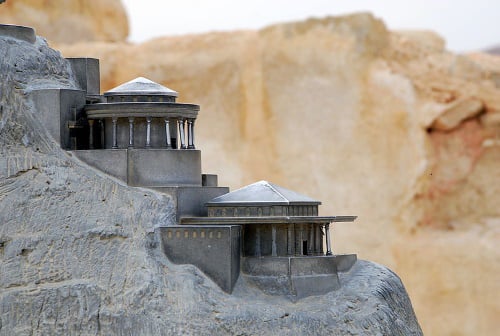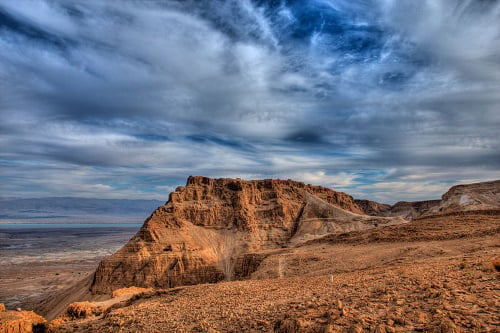At the edge of the Judean Desert, on a rocky plateau overlooking the Dead Sea, lies the excavated ruin of a royal citadel. It was the last stronghold held by the Jewish Zealots who refused to submit to Roman occupation. When they could hold out no longer, Masada became the backdrop for one of the most dramatic scenes in Jewish history.
In this article:
History of Masada
Rising over 1,200 feet above the surrounding desert and surrounded by deep gorges, the Masada plateau was naturally fortified. On the east, the earth fell in a straight drop to the Dead Sea. The path on that side was (and still is) called "the Snake" because of its narrowness and winding curves. The only other path, on the western side, was only slightly more traversable.
In the 1st century BCE, King Herod – slave-turned-Roman-backed governor of Israel — built an elaborate fortress on this mountain top, including spacious palaces, luxurious bathhouses, well-stocked storerooms, and twelve enormous cisterns. While he built the fortress out of fear (or paranoia) of Egypt, it also served him partially as a vacation home.
Years later, in 66 CE, Masada became a refuge for Jewish Zealots resisting Roman rule. They were led by Elazar ben Ya'ir. Following the conquest of Jerusalem and the destruction of the Second Temple in 69 CE, more Jews joined the group. They resisted Roman efforts to dislodge them and used Masada as their base for raids (against both Romans and opposing Jewish factions). With the perfectly-preserved food that Herod had stored, as well as the water from the cisterns, they could last indefinitely.

In 72 C.E. the Roman governor Flavius Silva decided to do away with this outpost of resistance once and for all. The 15,000 people of the Roman camp, which included the 10th Roman Legion as well as Jewish prisoners-of-war, prepared for a long siege against the 1,000 men, women and children on the mountain.
After failing to breach the wall on the east side, they built a long, broad assault ramp against the western side, using thousands of tons of stones and earth. Then, using a battering ram, they broke the stone wall of the fortress. The defenders had built another wall that the Romans could not break with the battering ram because it was soft and yielding. The Romans destroyed this wall with fire, and planned to enter the next day.
That night, Eleazar gathered all the Zealots and spoke to them. They decided to kill themselves rather than fall into the hands of Romans. Each man killed his wife and children, then the men drew lots and killed each other until the last man set fire to everything and killed himself.
In the morning, the Romans entered the fortress and found only dead bodies.
Two women and five children had survived the mass suicide by hiding in a cistern, which is how the story came to be known to the historian Josephus, who recorded it. Josephus is the only significant source of information about Masada.
Since the site of Masada was identified in 1838, discoveries and excavations have occurred regularly. Masada National Park was opened in 1966, and the Israel Nature and Parks Authority carries out conservation and restoration activities. Excavations are still ongoing.

Spiritual Significance of Masada
Jewish authorities differ on the question of suicide as exemplified by Masada. Some regard it as heroic martyrdom, but others say that while Jews must always be willing to accept martyrdom if necessary, it is wrong to kill oneself in anticipation of impending doom.
The morality of their decision notwithstanding, Masada tells a tale of heroism in the darkest moments. Masada thus became an instant attraction when it was excavated and opened to the public. It quickly became a symbol of courage for a people determined to be free in their own country. Indeed, Masada was the site of a heroic last stand of mythic proportions.

Another way of looking at it is that at Masada, Jews committed suicide in desperation, believing that all hope was lost, all faith was gone, the Jewish star had been totally eclipsed. It seemed that the Jewish people would fade from history. But that never happened. In fact, the population of Jews began to grow again. Masada is important because it tells the world that the Jewish legacy can not be erased, that Jewish fortune, even at its lowest point, is destined to revive and grow again. That Jews are the people of eternity.
Masada Today
Masada is on the southeast of Israel. A trip to Masada can be coupled with visits to the Dead Sea and/or the breathtaking Ein Gedi National Park.
The ascent to Masada from the east is either by cable car (for a minimal fee), or by walking up the Snake Path – a moderate climb which should take 45-60 minutes. From the west, the climb up the ramp that the Romans built takes an easy 15-20 minutes. You can reach the west side from the town of Arad. (There is no road around Masada, so it is approximately an hour and a quarter drive from the east entrance to the west.)
During the summer months, it can get dangerously hot in the Masada desert area. During this time, for safety reasons, you will not be allowed to make the trek up the mountain by foot unless you arrive in the early hours of the morning. The site opens for hikers an hour before sunrise. Always be sure to remain well-hydrated—bottles of water and a hat to protect from the sun are essential. At the eastern base of the mountain there's a gift shop, and they also sell really good kosher ice cream!

At night, a spectacular sound-and-light show dramatizing the history of Masada takes place on the west side of the mountaintop, where visitors are seated in a natural amphitheater. During the winter there is no sound-and-light show.
Information about park hours and fees can be found on the Israel Nature and National Parks Protection Authority's official website, www.parks.org.il. Click on "English site" and search for "Massada."
Masada Facts
- Some historians believe that the Zealots did not fight because there may have been Jewish captives forced to build the rampart and fight on the Roman side.
- Some of the most exciting sites that can be seen at Masada today include two mikvahs that have been found to perfectly meet all halachic standards, as well a synagogue, the only one still preserved from the time of the Second Temple.
- In order to provide water in middle of a desert where rainwater is woefully scarce – barely one inch of rain falls on an annual basis! – Herod built an intricate system of aqueducts to drain every drop of rainwater from the nearby wadis into the Masada cisterns.








Join the Discussion